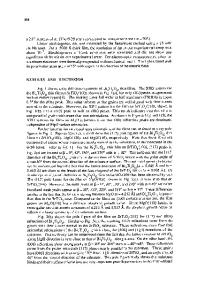Raman Spectra of Sr m-3 Bi 4 Ti m O 3m+3 Thin Films
- PDF / 77,432 Bytes
- 4 Pages / 595 x 842 pts (A4) Page_size
- 69 Downloads / 357 Views
C3.17.1
Raman Spectra of Srm-3Bi4TimO3m+3 Thin Films Jia Wang 1, Guangxu Cheng2, Shantao Zhang3, Hongwei Cheng3, Yanfeng Chen3 National Laboratory of Solid State Microstructures 1
Department of Physics, Nanjing University, Nanjing, 210093, China Center of Materials Analysis, Nanjing University, Nanjing, 210093, China 3 Department of Materials Science and Engineering, Nanjing University,Nanjing, 210093, China 2
ABSTRACT A series of bismuth layer-structured ferroelectrics thin films Srm-3Bi4TimO3m+3(m=3, 4, 5, and 6) were deposited by pulsed laser deposition (PLD) on (001) LaAlO3 single crystal substrate. XRD and Raman studies have been performed. The more sensitive Raman spectra lead to a different understanding on the layer structure of Sr3Bi4Ti6O21 from XRD. This can be attributed to the lager c-axis constant of Sr3Bi4Ti6O21 due to more layers. More layers lead to increasing disorder in the local scale of the average grain. INTRODUCTION In recent years, the bismuth layer-structured ferroelectrics (BLSFs) have been widely studied for their application to nonvolatile random access memory (NVFRAM) [1]. The structure of BLSFs is generally described as (Bi2O2)²+(Am-1BmO3m+1)² ,where A represents Bi,Pb,Sr,Ba ,etc., B represents Ti, Ta, Nb, Mo, Fe, etc., and m is the number of BO6 octahedral between two neighboring Bi2O2 layers. The mechanisms of phase transition of SrBi4Ti4O15 (SBTi4), Sr2Bi4Ti5O18 (SBTi5) and Sr3Bi4Ti6O21 (SBTi6) ceramics have been investigated with Raman scattering [2-4]. Because of the important applications and intriguing properties of SBTim thin films, Raman studies of the films are needed. In this paper, we presented the different results between XRD and Raman scattering studies. EXPERIMENT The PLD processes were performed with a KrF excimer laser at a wavelength of 248 nm and pulse with of 30 ns. The Bi4Ti3O12 (BTO) and SBTim thin films (150~200 nm) were prepared on LaAlO3 (LAO) substrates. Details about the growth conditions and parameters are described elsewhere [5]. The crystalline structures of thin films were studied by X-ray diffraction (XRD) using Cu Kα .Radiation on a Rigaku diffractometer. Raman scattering spectra were obtained as follows. The 488 nm light from an Ar ion laser was focused onto the sample surface. The temperature of the sample was controlled within 0.1 K (THMS600/HFS91). The backward scattering light was collected by an optical system (OLYMPUS BX41 system microscope) and
C3.17.2
was dispersed by a spectrometer (J.Y.LabRam HR with Notch filter and a CCD detector) with the frequency resolution of 0.6 cm-1. DISCUSSION Figure 1(a-d) show the XRD pattern of BTO and SBTim (m=4, 5 and 6) thin films deposited on LAO. Only (00l) peaks of these films can be detected. This indicates the highly c-axis oriented growth of these films.
Figure 1. XRD θ-2θscans patterns of thin films deposited on (001) LaAlO3 single crystal substrates: (a) BTO (b) SBTi4 (c) SBTi5 (d) SBTi6. The Raman spectra of the thin films are shown in figure 2(a-d). In BTO, SBTi4, SBTi5 and SBTi6 thin films, th
Data Loading...











